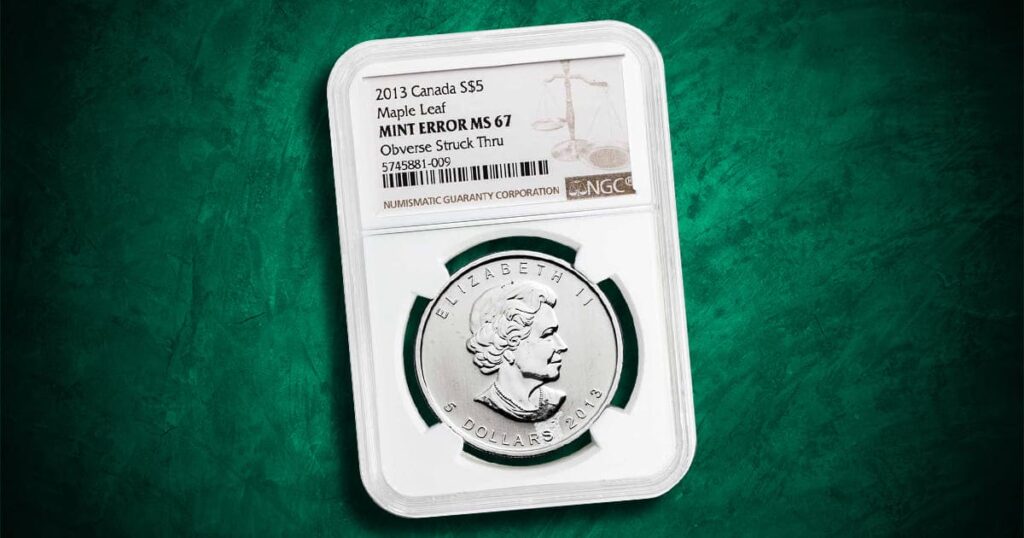
A Guide to Error Coins
Error Coins are coins that have man-made or mechanical errors. The errors occur either on the planchet, the dies or in striking. Sometimes an error is mad-made and intended, in order to create a rare coin = these are usually surreptitiously made.
Mechanical errors are generally unintended errors that happen unexpectedly.
Planchet Errors:
Blank planchet – A blank planchet error is one where the punched disks that are intended to be struck by the dies are not struck for some reason. They might be ejected prior to striking. If the blank is not struck it is usually a Type 1 error. If they have had uniformly rounded rims added via an upending mill machine and they are not struck, it is a Type 2 blank planchet.

A Type 1 Blank Planchet Error
Clipped Planchet – A clipped planchet usually occurs when the metal strip for the coins is misfeeds through the blanking machine unevenly. Sometimes the punch strike overlaps the straight edge or overlaps the hold punched for a previous coin. The clip can be small or large and either straight or curved.

Other planchet errors – Wrong metal, improper thickness, cracked or chipped planchets. Lamination errors, where the planchet metal separates.
Die Errors:
Doubled Die Error – A Doubled Die occurs when a misaligned striking impression from the hub strikes the planchet. It is not a re-punched die.

A 1955/55 Doubled Die Lincoln Cent
Die Clash – A die clash happens when the obverse and reverse dies strike one another without a blank planchet between them. This may cause damage to each die. In fact, parts of each die may be impressed into one another, and those incorrect die elements are now impressed into the new coins that are struck.

Overdate- Because of the cost and difficulty of making new does, the mints often used a die until it shattered. They would take last year’s die and replace the last digit in the date with a new digit. A similar thing could happen with mintmarks as the Philadelphia Mint would often share dies with the branch mints and those mints with each other.


1918/17-D Buffalo Nickel Overdate Error
Striking Errors:
Broadstrike Error – A broadstrike error occurs when the circular die surrounding the lower die permits the flowing metal to go outside the die. It results in the coins have plain and not reeded edges. The collar normally prevents the flowing metal from escaping from the die itself.

1921 Morgan Dollar with a large Broadstrike Error.
Strike-Through Error – A strike-Through error occurs when a foreign object comes between the die and the blank when it is being struck. The foreign object becomes impressed into the blank’s surface, and it distorts the finished product. Wire from a brush, string from a rag used to polish the dies, even grease that fills the die are often the culprits filling the dies instead of metal.

A strike-Through Error on a Morgan Silver Dollar.
Brockage Error – A Brockage error happens when the mirror image of one side is struck onto a blank. If the struck coin fails to automatically eject from the collar when a new blank is fed on top of the struck coin and the die. This creates a reverse impression onto the opposite side of a coin, This is a dramatic and desirable error.


A Reverse Brockage Error on a 1999 Jefferson Nickel.
Multiple Strike Error – A multiple strike error involves a coin that has been struck numerous times and you can see multiple images or multiple coins are involves and struck and stuck together, A dramatic error.

A Multiple Strike Error.
Off-Center Striking Error – Off-Center Errors are produced when a coin is struck off-center. The die being punched is not in the center of the coin, it is closer to the edge. The coin is no longer circular when that happens. The greater the amount of off-center strike, the scarcer and more valuable the coin becomes. Off-center coins with dates are the most desirable of all of these errors.

A 1972-D Off-Center Lincoln Cent.
Double Denomination Error – This dramatic error occurs when a coin is struck twice between two different denominations of coins. Again, a scarce and dramatic error.

An Eleven-Cent Coin, struck by Lincoln Cent dies as well as struck by Roosevelt Dime Dies. RARE!
Wrong Metal or Planchet Error – Coins may be struck on the wrong planchet or on a planchet made of the wrong metal. This usually happens when the coin is being struck and the wrong dies may be used or the wrong metal or planchet is accidentally substituted for the correct one and fed into the press.
All of these types of errors are highly prized by dealers and collectors as they generally happen infrequently. The error below is very scarce in that the metal is ALMOST correct. This Ukrainian coin is supposed to be struck on a .999 Fine planchet when instead it was struck on a Sterling .925 planchet which is very hard to detect, except usually non-invasive electronic measures.

A 2016 Ukrainian coin struck on a Sterling Planchet instead of being struck on a .999 Fine Planchet.





